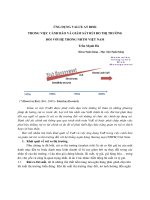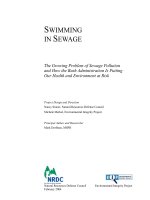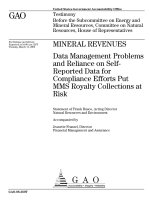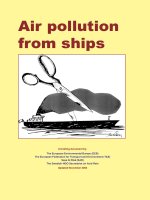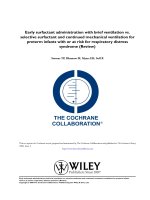Energy At Risk presentation
Bạn đang xem bản rút gọn của tài liệu. Xem và tải ngay bản đầy đủ của tài liệu tại đây (771.59 KB, 41 trang )
Energy Cost Control:
Show Me the Money!
A Financial Calculator
Christopher Russell
Energy PathFINDER
www.energypathfinder.com
(443) 636-7746
About Christopher Russell, C.E.M., C.R.M.
Energy Manager, Howard County
Maryland
Independent consulting since 2006
Principal, Energy Pathfinder
Director of Industrial Programs,
Alliance to Save Energy, 1999-2006
MBA, M.A., University of MD;
B.A., McGill University
Published
November 2009
2
Use the Top Manager’s Language!
3
OUTLINE FOR TODAY
• PART 1:
Economic Justification
• PART 2:
Economic Metrics
• PART 3:
“Making the Case” to Upper Management
4
U.S. INDUSTRY AVERAGE ENERGY DOLLAR
BREAKDOWN OF PRIMARY ENERGY SUPPLY
PLANT BOUNDARY
$0.49
$0.12
$0.05
$0.05
$0.28
NET APPLIED TO WORK
CONVERSION LOSS
ONSITE DISTRIBUTION LOSS
CENTRAL PLANT LOSS
(c)2009 Energy Pathfinder Mangement
Consulting, LLC
SOURCE: />www.energypathfinder.com
GENERATION,
TRANSMISSION,
DISTRIBUTION
LOSSES
PRIOR TO
DELIVERY
5
5
CHALLENGE FOR FACILITY MANAGERS
Facilities at the end of the budget “food chain”
Limited staff, resources, analytical capability
Evaluating 21st century energy improvements
with 1920s investment analysis techniques!
6
ABOUT ENERGY IMPROVEMENTS:
What do business leaders want to know?
• What’s the benefit?
– How many dollars?
– How quickly do the dollars accrue?
– What’s the risk of investing?
– What’s the risk of NOT investing?
• What’s the most that I should pay for it?
…per current investment criteria
• How does this compare to other ways to use
money?
7
OUTLINE FOR TODAY
• PART 1:
Economic Justification
• PART 2:
Economic Metrics
• PART 3:
“Making the Case” to Upper Management
8
ENERGY AT-RISK MODEL:
•Excel Spreadsheet provided by Xcel Energy
•You plug in project budget
•Model produces economic metrics
•Choose the best metric(s) for your audience
•Print results with your label/logo
9
• CONSTRUCTION BUDGET:
Project Cost: $16,000
Economic life: 25 years
Cost of Capital: 7%
TARGET: 1-YEAR PAYBACK
• ANNUAL CONSUMPTION:
Before:
246,667 kWh
After:
209,667 kWh
Elec @ $0.08/kWh
EXAMPLE:
• MAINTENANCE COSTS:
Pump Optimization
Before:
Annual overhaul costs @ $10,000
City of Milford, CT
After:
Annual overhaul costs @ $ 3,340
SOURCE: />
10
Economic Metrics
•
•
•
•
•
•
•
Simple Payback
Return on Investment
Life Cycle Cost
Net Present Value
Internal Rate of Return
Ratio: Conserve or Buy?
Cost of Doing Nothing
SIMPLE
SOPHISTICATED
INTEGRATIVE
11
YELLOW TABS
Data Entry
12
YELLOW TAB DEMO
13
GREEN TABS
Simple Metrics
14
Simple Payback
PROS
• Easy to understand
• Widely used
Total cost to
install
Simple
=
Payback
Annual operating
savings
1.7 Years =
$16,000
$9,620
FAILS TO MEET TARGET
CONS
• Measures TIME, does NOT measure profitability or full value created
• Fails to account for benefits accruing after payback period is achieved
• Analysis does not clearly isolate the impact of individual variables
• Poor indication of risk (variability of results)
• Difficult to accommodate future investments (like overhauls)
• Fails to measure the cost of NOT doing the project
15
PROBLEMS WITH “PAYBACK”
•
•
•
•
If a 12-month payback is better than 24 months…
Then a 6-month payback is better than 12 months…
So a zero-month payback must be best!
Because there’s no wait to get the money back!
If getting the money back is a concern,
then there’s no reason to make the investment.
16
Return on
Investment
ROI
=
Nominal Average
Annual Return
Total Nominal
Investment
$9,620
PROS
60.13% =
$16,000
• Easy to understand
• Good for comparing the attractiveness of two or more projects
CONS
• Indicates average rate of return only; note that ROI varies over individual
years
• Does not discriminate the value of returns from different years
• ROI is confined to the project only; contribution to overall profitability or
wealth is not measured
• Analysis does not clearly isolate the impact of individual variables
• Fails to measure the cost of NOT doing the project
17
Life-Cycle Cost
PROS
• Good for comparing the total
ownership for two or more similar
purpose projects.
Total cost of ownership, including
capital, operating costs and energy
consumption.
Maintenance
(1%)
Capital
(2%)
Energy
(97%)
CONS
• Difficult to implement as a practical management metric; no single person
of department clearly “owns” responsibility for life-cycle costs
• No indication of wealth created by the project or variability in profitability
• Not useful for comparing dissimilar projects
• Fails to measure the cost of NOT doing the project
18
GREEN TAB DEMO
19
RED TABS
Sophisticated Metrics
20
T
Net Present Value
(NPV)
∑
t-1
25
∑
t-1
Annual Cash Flowt
(1+r)t
$9,620
(1+.07)
t
-
Cash Flow
In Year0
-
$16,000
PROS
• Captures full measure of value added by the project’s returns
• Reflects risk by incorporating the time-value of money
• Excellent tool for ranking two or more options by the value they generate
CONS
• Entire calculation relies on a series of guesses about future returns
• Analysis fails isolate variables that can be linked to specific responsibilities
• Fails to measure the cost of NOT doing the project
21
Internal Rate
of Return
IRR = r so that:
Cash Flow
In Year0
T
+∑
t-1
Cash Flowt
(1+r)t
=0
Where “T” = economic life of the project in years
“t” represents each individual year in the project’s economic life
∑ indicates summation across all “t” years
PROS
• Measures rate of return for this project relative to any benchmark
• Reflects risk by incorporating the time-value of money
• Excellent tool for ranking two or more options by the value they generate
CONS
• Fails to measure the absolute value of wealth created
• Entire calculation relies on a series of guesses about future returns
• Analysis fails isolate variables that can be linked to specific responsibilities
• Fails to measure the cost of NOT doing the project
22
RED TAB DEMO
23
BLUE TABS
Integrative Metrics
24
Energy At-Risk
A
B
ANNUAL ENERGY
CONSUMPTION
Energy consumption
avoided by investing in
an energy-efficient
alternative
VOLUME AT-RISK:
Buy & waste or
Pay to avoid buying.
PAY FOR IT
EITHER WAY.
COMMITTED
ENERGY VOLUME:
Buy & use
as intended.
Annual energy use,
current application
in-place
Annual energy use,
efficient alternative
25
